Breast augmentation surgery, also known as breast implant surgery, is a popular procedure that helps enhance the size and shape of the breasts.
Call us to book an appointment with the best Surgeon near you.
Breast augmentation surgery is a cosmetic procedure designed to enhance the size and shape of the breasts. It is one of the most commonly performed plastic surgeries globally, helping women achieve their desired breast appearance. Whether you wish to increase the volume of your breasts, improve symmetry, or restore lost fullness, breast augmentation can be a transformative option. Breast augmentation can be performed using two main techniques: breast implants and fat transfer. Breast implants involve the insertion of silicone or saline-filled implants to enhance the breasts' size and shape. On the other hand, fat transfer augmentation utilizes the patient's own fat from another area of the body to augment the breasts. While breast augmentation is a highly individualized procedure, it is essential to have realistic expectations and understand the potential risks and benefits. Consulting with a board-certified plastic surgeon is crucial to determine the best approach for your specific goals and body type.
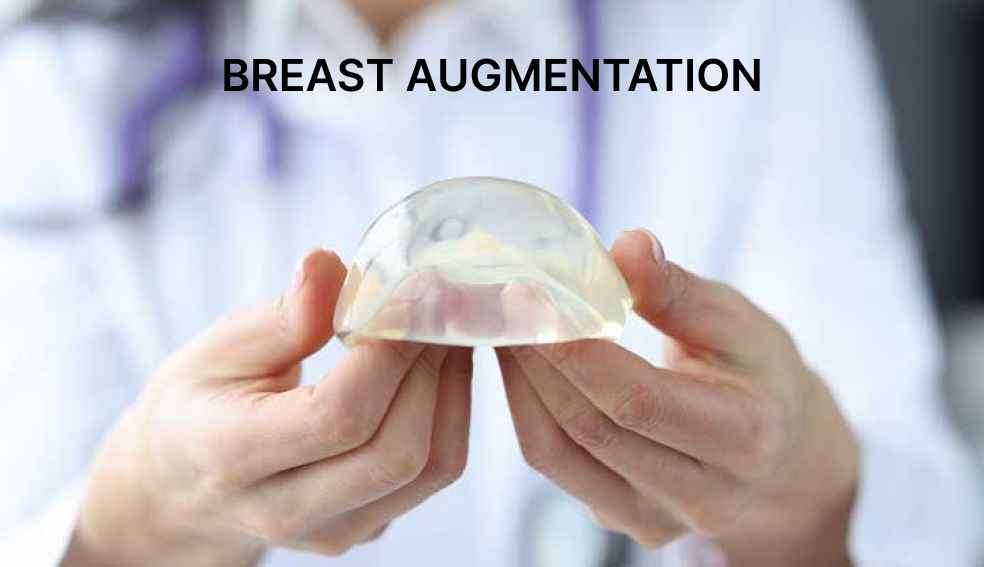
Breast augmentation surgery is a cosmetic procedure designed to enhance the size and shape of the breasts. It is one of the most commonly performed plastic surgeries globally, helping women achieve their desired breast appearance. Whether you wish to increase the volume of your breasts, improve symmetry, or restore lost fullness, breast augmentation can be a transformative option.
Breast augmentation can be performed using two main techniques: breast implants and fat transfer. Breast implants involve the insertion of silicone or saline-filled implants to enhance the breasts' size and shape. On the other hand, fat transfer augmentation utilizes the patient's own fat from another area of the body to augment the breasts.
While breast augmentation is a highly individualized procedure, it is essential to have realistic expectations and understand the potential risks and benefits. Consulting with a board-certified plastic surgeon is crucial to determine the best approach for your specific goals and body type.
Breast implants play a significant role in breast augmentation surgery. They come in various sizes, shapes, and materials, each offering unique advantages and considerations. The two primary types of breast implants are saline and silicone implants. Saline Breast Implants Saline breast implants are filled with a sterile saline solution, similar to the body's natural fluids. These implants consist of a silicone shell that is inserted into the breast pocket and then filled with saline. Saline implants offer several advantages, such as adjustable volume during surgery, smaller incisions, and a lower cost compared to silicone implants. Additionally, in the unlikely event of implant rupture, the saline solution is harmlessly absorbed by the body. Silicone Breast Implants Silicone breast implants are filled with a cohesive silicone gel, providing a more natural feel and appearance. The silicone gel closely resembles the consistency of human fat, making these implants popular among women seeking a realistic breast augmentation outcome. Silicone implants are pre-filled, requiring a slightly larger incision for placement. In case of implant rupture, the cohesive gel typically stays within the implant shell or the scar tissue around it, reducing the risk of leakage. The choice between saline and silicone breast implants depends on various factors, including personal preference, desired outcome, and the advice of your plastic surgeon. During your consultation, your surgeon will assess your individual needs and help you select the most suitable type of implant for your breast augmentation surgery.

Breast implants play a significant role in breast augmentation surgery. They come in various sizes, shapes, and materials, each offering unique advantages and considerations. The two primary types of breast implants are saline and silicone implants.
Saline Breast Implants
Saline breast implants are filled with a sterile saline solution, similar to the body's natural fluids. These implants consist of a silicone shell that is inserted into the breast pocket and then filled with saline. Saline implants offer several advantages, such as adjustable volume during surgery, smaller incisions, and a lower cost compared to silicone implants. Additionally, in the unlikely event of implant rupture, the saline solution is harmlessly absorbed by the body.
Silicone Breast Implants
Silicone breast implants are filled with a cohesive silicone gel, providing a more natural feel and appearance. The silicone gel closely resembles the consistency of human fat, making these implants popular among women seeking a realistic breast augmentation outcome. Silicone implants are pre-filled, requiring a slightly larger incision for placement. In case of implant rupture, the cohesive gel typically stays within the implant shell or the scar tissue around it, reducing the risk of leakage.
The choice between saline and silicone breast implants depends on various factors, including personal preference, desired outcome, and the advice of your plastic surgeon. During your consultation, your surgeon will assess your individual needs and help you select the most suitable type of implant for your breast augmentation surgery.
Before undergoing breast augmentation surgery, it is crucial to consider both the advantages and disadvantages of the procedure. Understanding the pros and cons can help you make an informed decision and manage your expectations effectively. Advantages of Breast Augmentation 1. Enhanced Self-Confidence: Breast augmentation can boost self-esteem and body confidence, allowing women to feel more comfortable in their own skin.
2. Customizable Results: Each breast augmentation procedure is tailored to the patient's desires and unique anatomy. The size, shape, and placement of the implants are customizable, ensuring a personalized outcome.
3. Long-Lasting Results: While breast implants are not permanent, they can last for many years before requiring replacement or revision surgery. This longevity ensures that patients can enjoy their augmented breasts for an extended period. 4. Improved Breast Symmetry: Breast augmentation surgery can address breast asymmetry, creating a more balanced and proportionate appearance.
5. Restored Volume: Women who have lost breast volume due to pregnancy, weight loss, or aging can regain fullness and achieve a more youthful breast contour through augmentation. Disadvantages of Breast Augmentation
1. Surgical Procedure: Breast augmentation is a surgical procedure that involves incisions and anesthesia. Patients should be aware of the potential risks and complications associated with any surgical intervention.
2. Downtime and Recovery: Recovery from breast augmentation surgery typically requires a period of downtime, during which physical activities may be limited. Patients should plan for a few weeks of rest and follow their surgeon's postoperative instructions diligently.
3. Potential Complications: Although rare, complications can occur following breast augmentation surgery. These include infection, bleeding, implant rupture, capsular contracture, changes in nipple sensation, and changes in breast appearance over time. 4. Financial Considerations: Breast augmentation surgery is typically not covered by health insurance, so patients should be prepared to cover the costs out of pocket. It is essential to discuss the financial aspect with your surgeon and explore available payment options.
5. Revision and Maintenance: While breast implants are long-lasting, they may require revision or replacement in the future. This could be due to personal preference, changes in breast appearance over time, or complications that may arise. Keep in mind that the advantages and disadvantages of breast augmentation can vary from person to person. It is crucial to have an open and honest discussion with your plastic surgeon to fully understand how these factors may apply to your specific circumstances
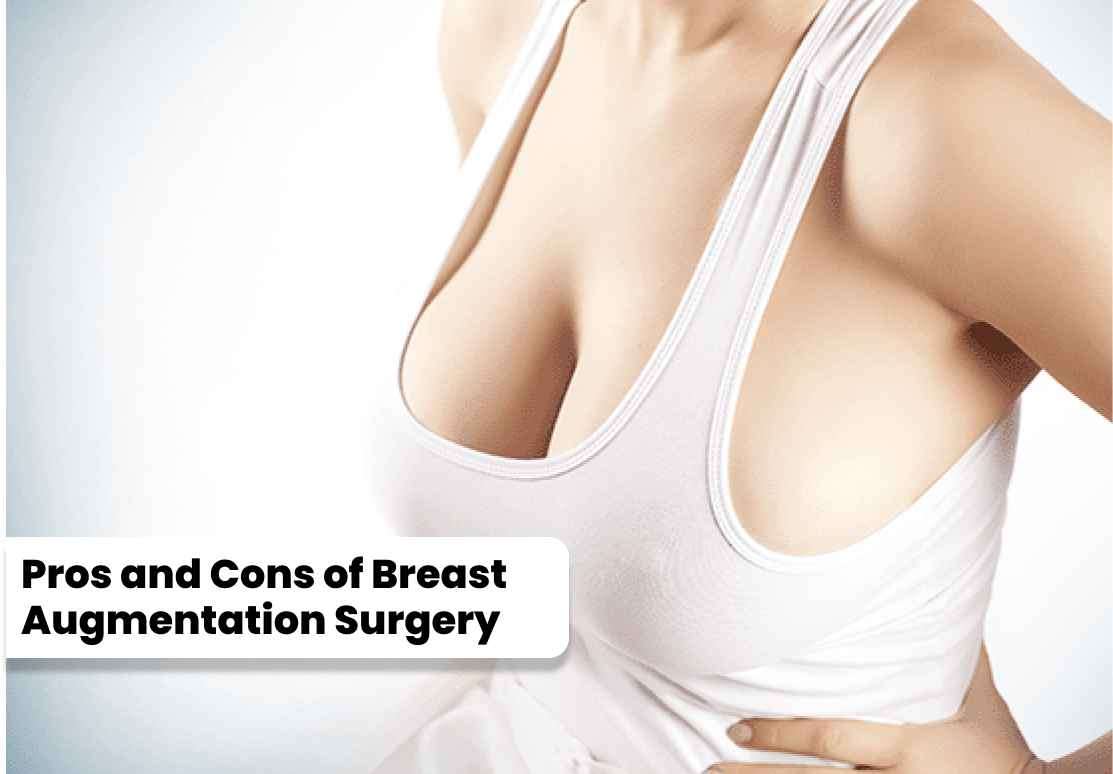
Before undergoing breast augmentation surgery, it is crucial to consider both the advantages and disadvantages of the procedure. Understanding the pros and cons can help you make an informed decision and manage your expectations effectively.
Advantages of Breast Augmentation
1. Enhanced Self-Confidence: Breast augmentation can boost self-esteem and body confidence, allowing women to feel more comfortable in their own skin.
2. Customizable Results: Each breast augmentation procedure is tailored to the patient's desires and unique anatomy. The size, shape, and placement of the implants are customizable, ensuring a personalized outcome.
3. Long-Lasting Results: While breast implants are not permanent, they can last for many years before requiring replacement or revision surgery. This longevity ensures that patients can enjoy their augmented breasts for an extended period.
4. Improved Breast Symmetry: Breast augmentation surgery can address breast asymmetry, creating a more balanced and proportionate appearance.
5. Restored Volume: Women who have lost breast volume due to pregnancy, weight loss, or aging can regain fullness and achieve a more youthful breast contour through augmentation.
Disadvantages of Breast Augmentation
1. Surgical Procedure: Breast augmentation is a surgical procedure that involves incisions and anesthesia. Patients should be aware of the potential risks and complications associated with any surgical intervention.
2. Downtime and Recovery: Recovery from breast augmentation surgery typically requires a period of downtime, during which physical activities may be limited. Patients should plan for a few weeks of rest and follow their surgeon's postoperative instructions diligently.
3. Potential Complications: Although rare, complications can occur following breast augmentation surgery. These include infection, bleeding, implant rupture, capsular contracture, changes in nipple sensation, and changes in breast appearance over time.
4. Financial Considerations: Breast augmentation surgery is typically not covered by health insurance, so patients should be prepared to cover the costs out of pocket. It is essential to discuss the financial aspect with your surgeon and explore available payment options.
5. Revision and Maintenance: While breast implants are long-lasting, they may require revision or replacement in the future. This could be due to personal preference, changes in breast appearance over time, or complications that may arise.
Keep in mind that the advantages and disadvantages of breast augmentation can vary from person to person. It is crucial to have an open and honest discussion with your plastic surgeon to fully understand how these factors may apply to your specific circumstances
Selecting the right plastic surgeon is a crucial step in your breast augmentation journey. A board-certified plastic surgeon with expertise in breast augmentation can provide you with the highest level of care and ensure optimal results. Here are some essential considerations when choosing a surgeon: 1. Certification: Verify that your surgeon is certified by the relevant board, such as the American Board of Plastic Surgery or equivalent board in your country. Certification demonstrates the surgeon's commitment to meeting rigorous standards of safety and proficiency.
2. Experience and Expertise: Look for a surgeon who has extensive experience performing breast augmentation surgeries. A surgeon with a proven track record and specialization in breast procedures can offer valuable insights and deliver the best possible outcome.
3. Patient Reviews and Testimonials: Read reviews and testimonials from previous patients to gauge their satisfaction with the surgeon's skills, bedside manner, and overall experience. Online platforms and reputable review websites can provide helpful feedback.
4. Before and After Photos: Review the surgeon's before and after photos of breast augmentation procedures to assess the quality and consistency of their work. This will give you an idea of the surgeon's aesthetic approach and the potential results you can expect. 5. Communication and Comfort: Schedule a consultation with your chosen surgeon to discuss your goals, expectations, and any concerns you may have. Pay attention to their communication style, attentiveness, and ability to address your questions satisfactorily. A good rapport and mutual understanding are essential for a successful surgical journey. Choosing the right surgeon is a critical aspect of ensuring a safe and satisfying breast augmentation experience. Take the time to research and consult with multiple surgeons before making a final decision.

Selecting the right plastic surgeon is a crucial step in your breast augmentation journey. A board-certified plastic surgeon with expertise in breast augmentation can provide you with the highest level of care and ensure optimal results. Here are some essential considerations when choosing a surgeon:
1. Certification: Verify that your surgeon is certified by the relevant board, such as the American Board of Plastic Surgery or equivalent board in your country. Certification demonstrates the surgeon's commitment to meeting rigorous standards of safety and proficiency.
2. Experience and Expertise: Look for a surgeon who has extensive experience performing breast augmentation surgeries. A surgeon with a proven track record and specialization in breast procedures can offer valuable insights and deliver the best possible outcome.
3. Patient Reviews and Testimonials: Read reviews and testimonials from previous patients to gauge their satisfaction with the surgeon's skills, bedside manner, and overall experience. Online platforms and reputable review websites can provide helpful feedback.
4. Before and After Photos: Review the surgeon's before and after photos of breast augmentation procedures to assess the quality and consistency of their work. This will give you an idea of the surgeon's aesthetic approach and the potential results you can expect.
5. Communication and Comfort: Schedule a consultation with your chosen surgeon to discuss your goals, expectations, and any concerns you may have. Pay attention to their communication style, attentiveness, and ability to address your questions satisfactorily. A good rapport and mutual understanding are essential for a successful surgical journey.
Choosing the right surgeon is a critical aspect of ensuring a safe and satisfying breast augmentation experience. Take the time to research and consult with multiple surgeons before making a final decision.
Proper
preparation before breast augmentation surgery is essential for a
smooth and successful procedure. Your surgeon will provide you with
detailed instructions to follow in the weeks leading up to your surgery.
Here are some general considerations to keep in mind: Consultation and Evaluation Before scheduling
your breast augmentation surgery, you will have an initial consultation
with your plastic surgeon. During this consultation, you will discuss
your goals, medical history, and any concerns you may have. Your surgeon
will evaluate your breast anatomy, skin quality, and overall health to
determine if you are a suitable candidate for the procedure. They will
also explain the surgical process, potential risks, and expected
outcomes. It is important to be
open and honest during this consultation. Discuss your desired breast
size, shape, and any specific concerns you have. Your surgeon will work
with you to develop a personalized surgical plan that aligns with your
goals and ensures a safe procedure. Preoperative Instructions Your surgeon will
provide you with specific preoperative instructions to follow in the
days or weeks leading up to your surgery. These instructions may
include:
1. Medication Management:
You may need to adjust or discontinue certain medications or
supplements that can increase the risk of bleeding or interfere with
anesthesia. Follow your surgeon's guidelines regarding medication usage.
2. Smoking Cessation:
Smoking can impair the healing process and increase the risk of
complications. It is strongly recommended to quit smoking at least
several weeks before and after your surgery. 3. Laboratory Tests:
Your surgeon may request certain laboratory tests, such as blood work
or imaging, to ensure you are in good overall health and to assess your
breast tissue.
4. Fasting:
You will likely be instructed to avoid eating or drinking anything for a
certain period before your surgery. This is to ensure your stomach is
empty and reduce the risk of complications during anaesthesia.
5. Arrangements for Recovery:
Plan for someone to accompany you on the day of surgery and assist you
during the initial phase of recovery. You may need help with
transportation, household chores, and personal care during the first few
days. Following your surgeon's preoperative instructions diligently will help optimize your safety and the success of your breast augmentation surgery.
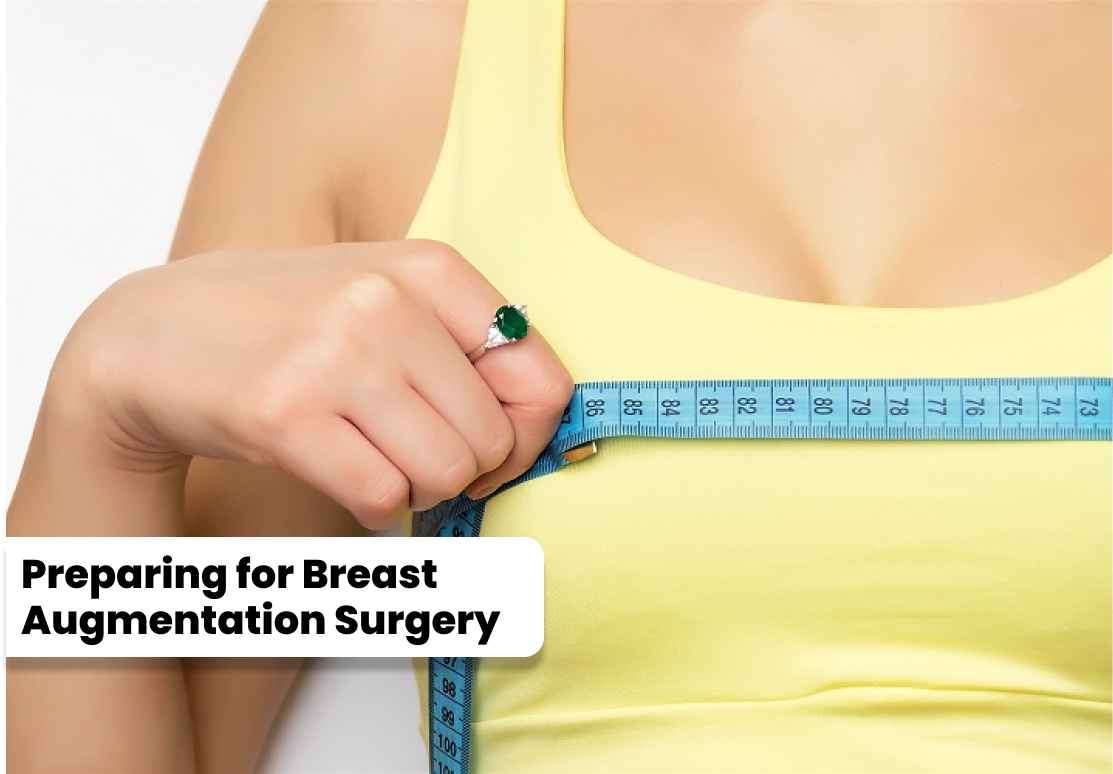
Proper
preparation before breast augmentation surgery is essential for a
smooth and successful procedure. Your surgeon will provide you with
detailed instructions to follow in the weeks leading up to your surgery.
Here are some general considerations to keep in mind:
Consultation and Evaluation
Before scheduling your breast augmentation surgery, you will have an initial consultation with your plastic surgeon. During this consultation, you will discuss your goals, medical history, and any concerns you may have. Your surgeon will evaluate your breast anatomy, skin quality, and overall health to determine if you are a suitable candidate for the procedure. They will also explain the surgical process, potential risks, and expected outcomes.
It is important to be
open and honest during this consultation. Discuss your desired breast
size, shape, and any specific concerns you have. Your surgeon will work
with you to develop a personalized surgical plan that aligns with your
goals and ensures a safe procedure.
Preoperative Instructions
Your surgeon will
provide you with specific preoperative instructions to follow in the
days or weeks leading up to your surgery. These instructions may
include:
1. Medication Management:
You may need to adjust or discontinue certain medications or
supplements that can increase the risk of bleeding or interfere with
anesthesia. Follow your surgeon's guidelines regarding medication usage.
2. Smoking Cessation:
Smoking can impair the healing process and increase the risk of
complications. It is strongly recommended to quit smoking at least
several weeks before and after your surgery.
3. Laboratory Tests:
Your surgeon may request certain laboratory tests, such as blood work
or imaging, to ensure you are in good overall health and to assess your
breast tissue.
4. Fasting:
You will likely be instructed to avoid eating or drinking anything for a
certain period before your surgery. This is to ensure your stomach is
empty and reduce the risk of complications during anaesthesia.
5. Arrangements for Recovery:
Plan for someone to accompany you on the day of surgery and assist you
during the initial phase of recovery. You may need help with
transportation, household chores, and personal care during the first few
days.
Following your surgeon's preoperative instructions diligently will help optimize your safety and the success of your breast augmentation surgery.
Proper postoperative care is crucial for a smooth recovery after breast augmentation surgery. Following your surgeon's instructions will help minimize discomfort, reduce the risk of complications, and optimize your results. Here are some essential guidelines for the recovery period: Immediate Postoperative Period After your surgery, you will be taken to a recovery area where you will be closely monitored until you are ready to go home. Some common postoperative experiences include:
1. Discomfort and Pain: It is normal to experience some discomfort, swelling, and tightness in the chest area after surgery. Your surgeon will prescribe pain medication to manage any pain during the initial recovery period. 2. Dressing and Bandages: Your incisions will be covered with surgical dressings or bandages to protect the incision sites and promote healing. Your surgeon will provide instructions on how to care for the dressings and when to change them.
3. Supportive Garments: You may be advised to wear a supportive bra or compression garment to minimize swelling and provide support to the healing breasts. Follow your surgeon's recommendations regarding the type and duration of garment use.
4. Drainage Tubes: In some cases, your surgeon may place small drainage tubes to remove excess fluid from the surgical site. These tubes will be removed during a follow-up visit once the drainage decreases.
5. Activity Restrictions: Your surgeon will provide guidelines on physical activity restrictions during the initial recovery period. It is crucial to avoid strenuous activities, heavy lifting, and intense exercise as directed to prevent complications and promote proper healing.
6. Follow-up Appointments: Your surgeon will schedule follow-up appointments to monitor your healing progress, remove any sutures or dressings, and address any concerns or questions you may have. Long-term Recovery While the initial recovery period may last a few weeks, complete healing and the final results of breast augmentation can take several months. Here are some long-term recovery considerations:
1. Scar Management: Your surgeon will provide instructions on scar management techniques to minimize the appearance of scars over time. This may include scar massage, topical treatments, and sun protection.
2. Physical Activity: Gradually resume physical activities and exercise as recommended by your surgeon. Follow a gradual progression to avoid strain or complications. It is essential to listen to your body and prioritize your comfort and well-being during the recovery process.
3. Breast Changes: It is normal for your breasts to continue to settle and change in shape and position over the first few months following surgery. Be patient as the final results gradually emerge. 4. Regular Follow-up: Maintain regular follow-up appointments with your surgeon to monitor your long-term results, address any concerns or questions, and undergo routine check-ups. Remember that every individual's healing process is unique, and individual experiences may vary. It is essential to follow your surgeon's postoperative instructions diligently to ensure optimal healing and long-term satisfaction with your breast augmentation results.
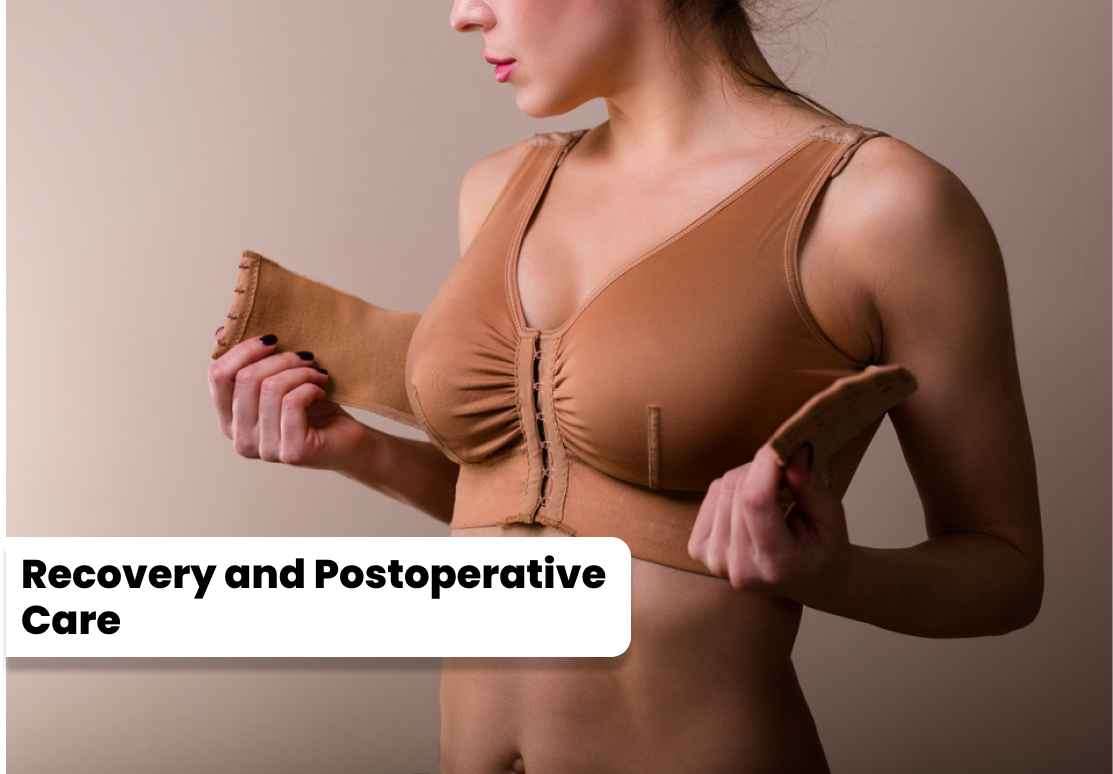
Proper postoperative care is crucial for a smooth recovery after breast augmentation surgery. Following your surgeon's instructions will help minimize discomfort, reduce the risk of complications, and optimize your results. Here are some essential guidelines for the recovery period:
Immediate Postoperative Period
After your surgery, you will be taken to a recovery area where you will be closely monitored until you are ready to go home. Some common postoperative experiences include:
1. Discomfort and Pain: It is normal to experience some discomfort, swelling, and tightness in the chest area after surgery. Your surgeon will prescribe pain medication to manage any pain during the initial recovery period.
2. Dressing and Bandages: Your incisions will be covered with surgical dressings or bandages to protect the incision sites and promote healing. Your surgeon will provide instructions on how to care for the dressings and when to change them.
3. Supportive Garments: You may be advised to wear a supportive bra or compression garment to minimize swelling and provide support to the healing breasts. Follow your surgeon's recommendations regarding the type and duration of garment use.
4. Drainage Tubes: In some cases, your surgeon may place small drainage tubes to remove excess fluid from the surgical site. These tubes will be removed during a follow-up visit once the drainage decreases.
5. Activity Restrictions: Your surgeon will provide guidelines on physical activity restrictions during the initial recovery period. It is crucial to avoid strenuous activities, heavy lifting, and intense exercise as directed to prevent complications and promote proper healing.
6. Follow-up Appointments: Your surgeon will schedule follow-up appointments to monitor your healing progress, remove any sutures or dressings, and address any concerns or questions you may have.
Long-term Recovery
While the initial recovery period may last a few weeks, complete healing and the final results of breast augmentation can take several months. Here are some long-term recovery considerations:
1. Scar Management: Your surgeon will provide instructions on scar management techniques to minimize the appearance of scars over time. This may include scar massage, topical treatments, and sun protection.
2. Physical Activity: Gradually resume physical activities and exercise as recommended by your surgeon. Follow a gradual progression to avoid strain or complications. It is essential to listen to your body and prioritize your comfort and well-being during the recovery process.
3. Breast Changes: It is normal for your breasts to continue to settle and change in shape and position over the first few months following surgery. Be patient as the final results gradually emerge.
4. Regular Follow-up: Maintain regular follow-up appointments with your surgeon to monitor your long-term results, address any concerns or questions, and undergo routine check-ups.
Remember that every individual's healing process is unique, and individual experiences may vary. It is essential to follow your surgeon's postoperative instructions diligently to ensure optimal healing and long-term satisfaction with your breast augmentation results.
Like
any surgical procedure, breast augmentation surgery carries certain
risks and potential complications. While complications are relatively
rare, it is important to be aware of them and make an informed decision.
Some potential risks and complications associated with breast
augmentation include:
1. Infection:
Although uncommon, infection can occur following breast augmentation
surgery. Your surgeon will prescribe antibiotics and provide detailed
instructions on wound care to minimize the risk of infection.
2. Hematoma:
A hematoma is a collection of blood that accumulates around the
surgical site. It may require drainage to prevent complications such as
infection or implant malposition.
3. Capsular Contracture:
Capsular contracture is the formation of excessive scar tissue around
the breast implant, resulting in firmness, discomfort, and potential
changes in breast shape. In severe cases, surgical intervention may be
necessary to correct the condition. 4. Implant Rupture or Leakage:
Implant rupture or leakage can occur, although it is rare. Saline
implants deflate rapidly if a rupture occurs, while silicone implants
may leak slowly. Regular monitoring and follow-up with your surgeon are
important for the early detection and management of implant issues.
5. Changes in Nipple Sensation:
Temporary or permanent changes in nipple sensation can occur after
breast augmentation surgery. Most commonly, nipple sensation returns to
normal within a few months, but in some cases, it may be permanently
altered. 6. Changes in Breastfeeding:
Breast augmentation surgery does not typically hinder a woman's ability
to breastfeed. However, it is important to discuss your breastfeeding
goals with your surgeon during the consultation to ensure appropriate
incision placement and minimize potential complications. It is crucial to have
open and honest communication with your surgeon and follow their pre
and postoperative instructions diligently to minimize the risk of
complications. Remember to discuss any concerns or questions you may
have during your consultation and follow-up appointments.
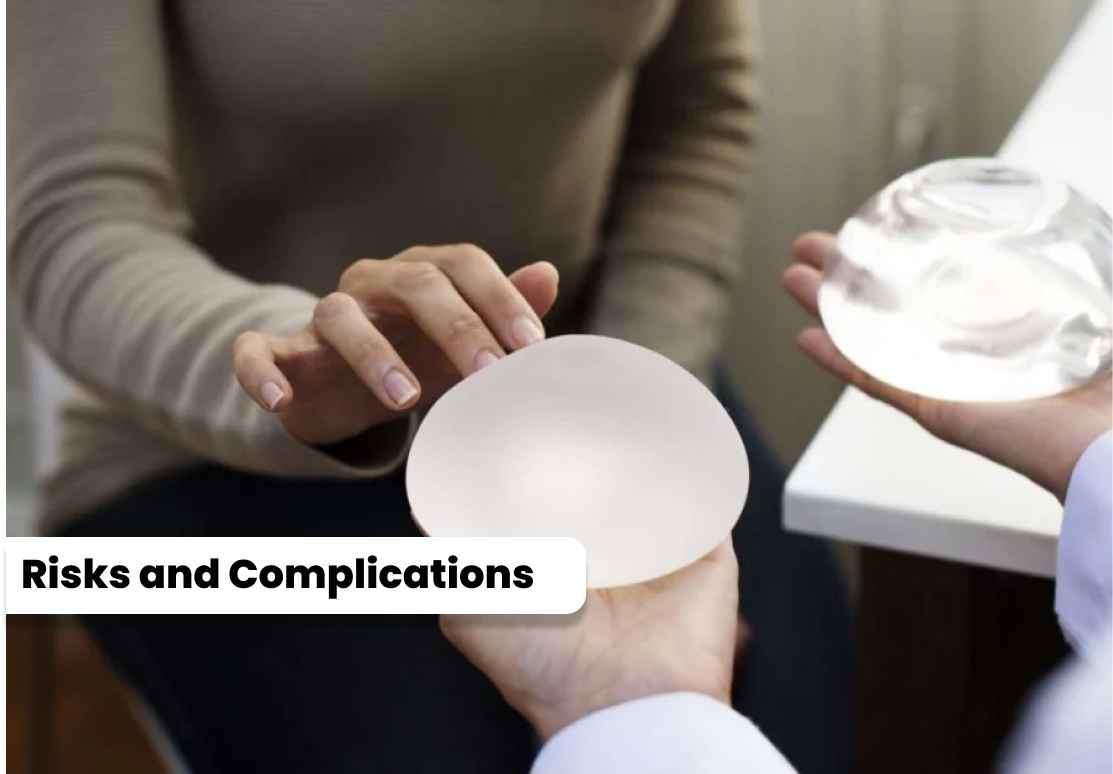
Like
any surgical procedure, breast augmentation surgery carries certain
risks and potential complications. While complications are relatively
rare, it is important to be aware of them and make an informed decision.
Some potential risks and complications associated with breast
augmentation include:
1. Infection:
Although uncommon, infection can occur following breast augmentation
surgery. Your surgeon will prescribe antibiotics and provide detailed
instructions on wound care to minimize the risk of infection.
2. Hematoma:
A hematoma is a collection of blood that accumulates around the
surgical site. It may require drainage to prevent complications such as
infection or implant malposition.
3. Capsular Contracture:
Capsular contracture is the formation of excessive scar tissue around
the breast implant, resulting in firmness, discomfort, and potential
changes in breast shape. In severe cases, surgical intervention may be
necessary to correct the condition. 4. Implant Rupture or Leakage:
Implant rupture or leakage can occur, although it is rare. Saline
implants deflate rapidly if a rupture occurs, while silicone implants
may leak slowly. Regular monitoring and follow-up with your surgeon are
important for the early detection and management of implant issues.
5. Changes in Nipple Sensation:
Temporary or permanent changes in nipple sensation can occur after
breast augmentation surgery. Most commonly, nipple sensation returns to
normal within a few months, but in some cases, it may be permanently
altered. 6. Changes in Breastfeeding:
Breast augmentation surgery does not typically hinder a woman's ability
to breastfeed. However, it is important to discuss your breastfeeding
goals with your surgeon during the consultation to ensure appropriate
incision placement and minimize potential complications. It is crucial to have
open and honest communication with your surgeon and follow their pre
and postoperative instructions diligently to minimize the risk of
complications. Remember to discuss any concerns or questions you may
have during your consultation and follow-up appointments.
Breast implant safety is a significant consideration for individuals considering breast augmentation surgery. Over the years, advancements in implant technology and increased safety regulations have significantly improved the overall safety of breast implants. Here are some important aspects of breast implant safety: Breast Implant-Associated Anaplastic Large Cell Lymphoma (BIA-ALCL) Breast implant-associated anaplastic large cell lymphoma (BIA-ALCL) is a rare type of lymphoma associated with textured breast implants. It is essential to note that BIA-ALCL is extremely rare, and the vast majority of individuals with breast implants will never develop this condition. The risk of BIA-ALCL is higher with textured implants compared to smooth implants. The symptoms of BIA-ALCL typically include swelling, pain, and changes in breast shape. If you experience any of these symptoms, contact your surgeon promptly for an evaluation. Early detection and appropriate management can lead to successful treatment.

Breast implant safety is a significant consideration for individuals considering breast augmentation surgery. Over the years, advancements in implant technology and increased safety regulations have significantly improved the overall safety of breast implants. Here are some important aspects of breast implant safety:
Breast Implant-Associated Anaplastic Large Cell Lymphoma (BIA-ALCL)
Breast implant-associated anaplastic large cell lymphoma (BIA-ALCL) is a rare type of lymphoma associated with textured breast implants. It is essential to note that BIA-ALCL is extremely rare, and the vast majority of individuals with breast implants will never develop this condition. The risk of BIA-ALCL is higher with textured implants compared to smooth implants.
The symptoms of BIA-ALCL typically include swelling, pain, and changes in breast shape. If you experience any of these symptoms, contact your surgeon promptly for an evaluation. Early detection and appropriate management can lead to successful treatment.
The cost of breast augmentation surgery in India starts from Rs. 100,000. The average cost is Rs 168,056 and the maximum price is Rs. 500,000 1. Here are the average costs of breast augmentation surgery in 30 Indian cities:
|
Serial No |
City |
Cost (INR) |
|
1 |
Bangalore |
200,000 |
|
2 |
Ahmedabad |
155,000 |
|
3 |
Bhubaneswar |
155,000 |
|
4 |
Chandigarh |
155,000 |
|
5 |
Chennai |
200,000 |
|
6 |
Coimbatore |
155,000 |
|
7 |
Delhi |
200,000 |
|
8 |
Ernakulam |
155,000 |
|
9 |
Gurgaon |
120,000 |
|
10 |
Hyderabad |
200,000 |
|
11 |
Indore |
155,000 |
|
12 |
Kanpur |
155,000 |
|
13 |
Kolkata |
155,000 |
|
14 |
Mumbai |
200,000 |
|
15 |
Nagpur |
155,000 |
|
16 |
Pune |
200,000 |
|
17 |
Vijayawada |
155,000 |
|
18 |
Visakhapatnam |
155,000 |
|
19 |
Agra |
97500 |
|
20 |
Surat |
100000 |
|
21 |
Pune |
140000 |
|
22 |
Jaipur |
115000 |
|
23 |
Lucknow |
175000 |
|
24 |
Patna |
112500 |
|
25 |
Vadodara |
110000 |
|
26 |
Ghaziabad |
120000 |
|
27 |
Meerut |
125000 |
|
28 |
Rajkot |
120000 |
|
29 |
Dhanbad |
125000 |
|
30 |
Ranchi |
112500 |
Please note that these figures are approximate and subject to variation. It's important to consult with healthcare professionals or institutions directly for precise and up-to-date cost estimates tailored to your specific circumstances
|
Serial No |
Hospital |
City |
|
1 |
All India Institute of Medical Sciences |
New Delhi |
|
2 |
Medanta The Medicity |
Gurgaon |
|
3 |
The Christian Medical College |
Vellore |
|
4 |
PGIMER - Postgraduate Institute of Medical Education |
Chandigarh |
|
5 |
Apollo Hospital - Chennai |
Chennai |
|
6 |
P. D. Hinduja National Hospital & Medical Research |
Mumbai |
|
7 |
Breach Candy Hospital |
Mumbai |
|
8 |
Fortis Flt. Lt. Rajan Dhall Hospital |
New Delhi |
|
9 |
King Edward Memorial Hospital |
Mumbai |
|
10 |
Indraprastha Apollo Hospital |
Delhi |
|
11 |
Lilavati Hospital And Research Centre |
Mumbai |
|
12 |
Sir Ganga Ram Hospital |
Delhi |
|
13 |
Bombay Hospital & Medical Research Centre |
Mumbai |
|
14 |
Apollo Health City - Jubilee Hills |
Hyderabad |
|
15 |
Fortis Hiranandani Hospital |
Mumbai |
|
16 |
Fortis Hospital Mulund |
Mumbai |
|
17 |
Jaslok Hospital and Research Centre |
Mumbai |
|
18 |
Manipal Hospitals |
Bengaluru |
|
19 |
Yashoda Hospital Secunderabad |
Hyderabad |
|
20 |
Apollo Hospitals - Bannerghatta Road |
Bengaluru |
|
21 |
Dr. Balabhai Nanavati Hospital |
Mumbai |
|
22 |
Max Super Speciality Hospital Saket |
New Delhi |
|
23 |
Jawaharlal Institute of Postgraduate Medical Education and Research |
Puducherry |
|
24 |
Saifee Hospital |
Mumbai |
|
25 |
Kokilaben Dhirubhai Ambani Hospital & Medical Research Institute |
Mumbai |
|
26 |
Aster CMI Hospital |
Bengaluru |
|
27 |
Safdarjung Hospital |
New Delhi |
|
28 |
Kolkata Institute of Post Graduate Medical Education and Research |
Kolkata |
|
29 |
AMRI Hospital |
Kolkata |
|
30 |
Kauvery Hospital |
Chennai |
Please Wait..